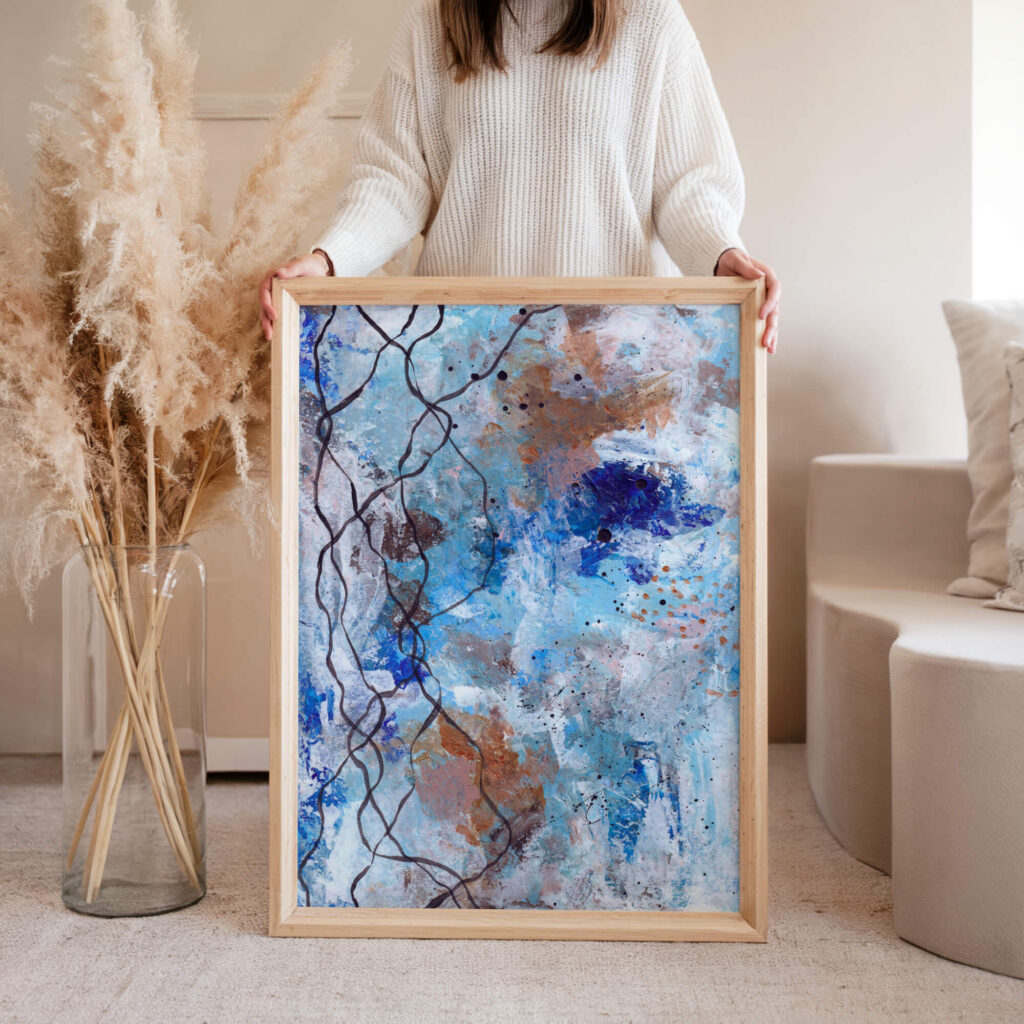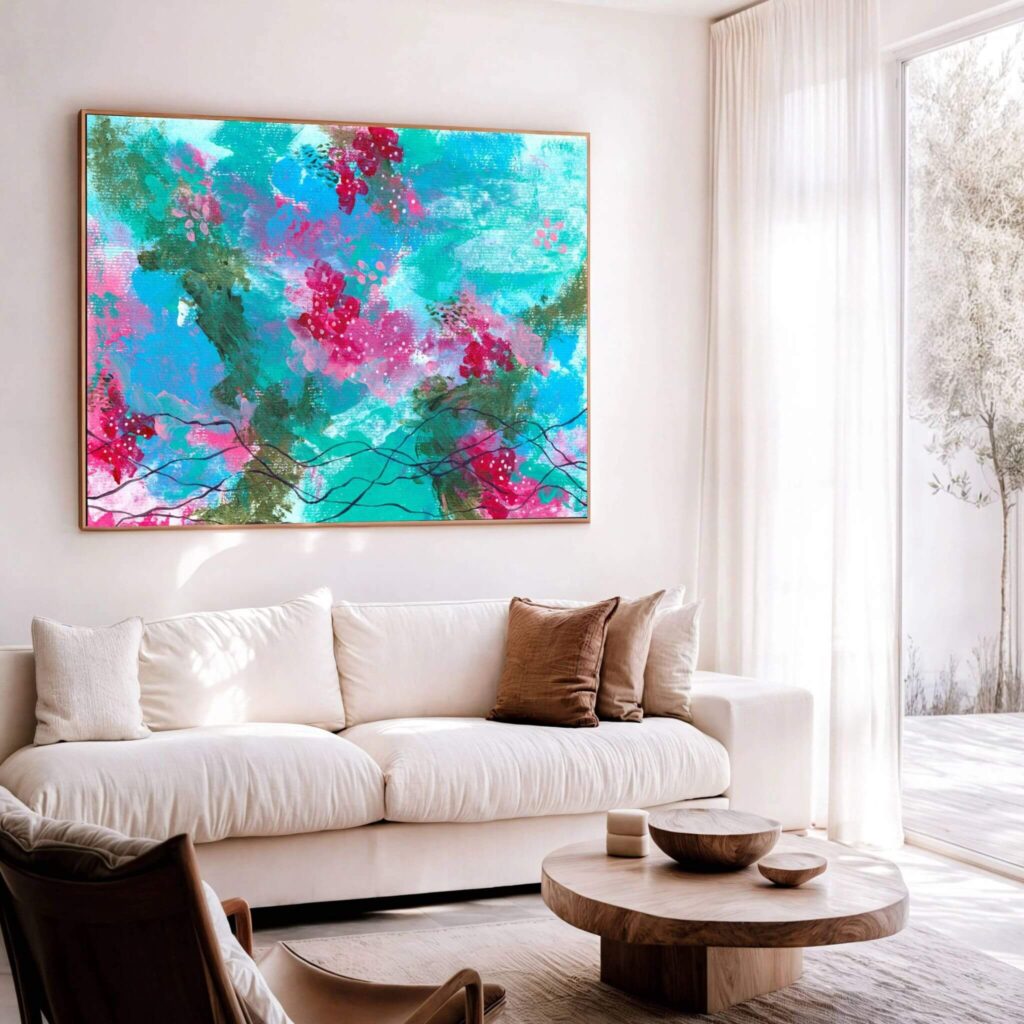How to Understand Abstract Art: A Luxury Collector’s Guide
You Don’t Need to “Get” Abstract Art to Be Moved by It
Most people are more comfortable around art when it tells them what it is. A portrait says: this is someone’s face. A landscape says: this is what the light looked like that day. Even surrealism gives you clues. But abstract art, real abstract art, doesn’t give you a map. It doesn’t need to.
And that’s what makes it feel intimidating to people trying to understand abstract art for the first time, especially if they’ve never had a chance to really slow down with it.
In truth, abstract art isn’t difficult. It’s just different. It asks something else from you. Not art knowledge. Not clever interpretation. But presence. Permission to feel. A bit of curiosity. And the willingness to be changed by something without knowing exactly how.
I wrote this guide for people like that. People like me. People who want to surround themselves with meaning, not just material. Whether you’re designing a healing interior, looking to collect with more intention, or simply craving art that actually does something to you, this isn’t about being an expert. This is about learning how to notice what’s happening when a piece stops you in your tracks.
You don’t need a degree to understand abstract art. You just need a bit of stillness, and a willingness to stay with what you feel, even if you don’t yet know why.
You won’t find jargon here. No inflated theory or recycled history-book answers. Just a slow, honest guide from the inside of the studio, built from lived experience, not from guesswork. Because abstract art isn’t some separate elite world. It’s a mirror. And the more you bring your own self to it, the more it gives back.
Let’s begin there.
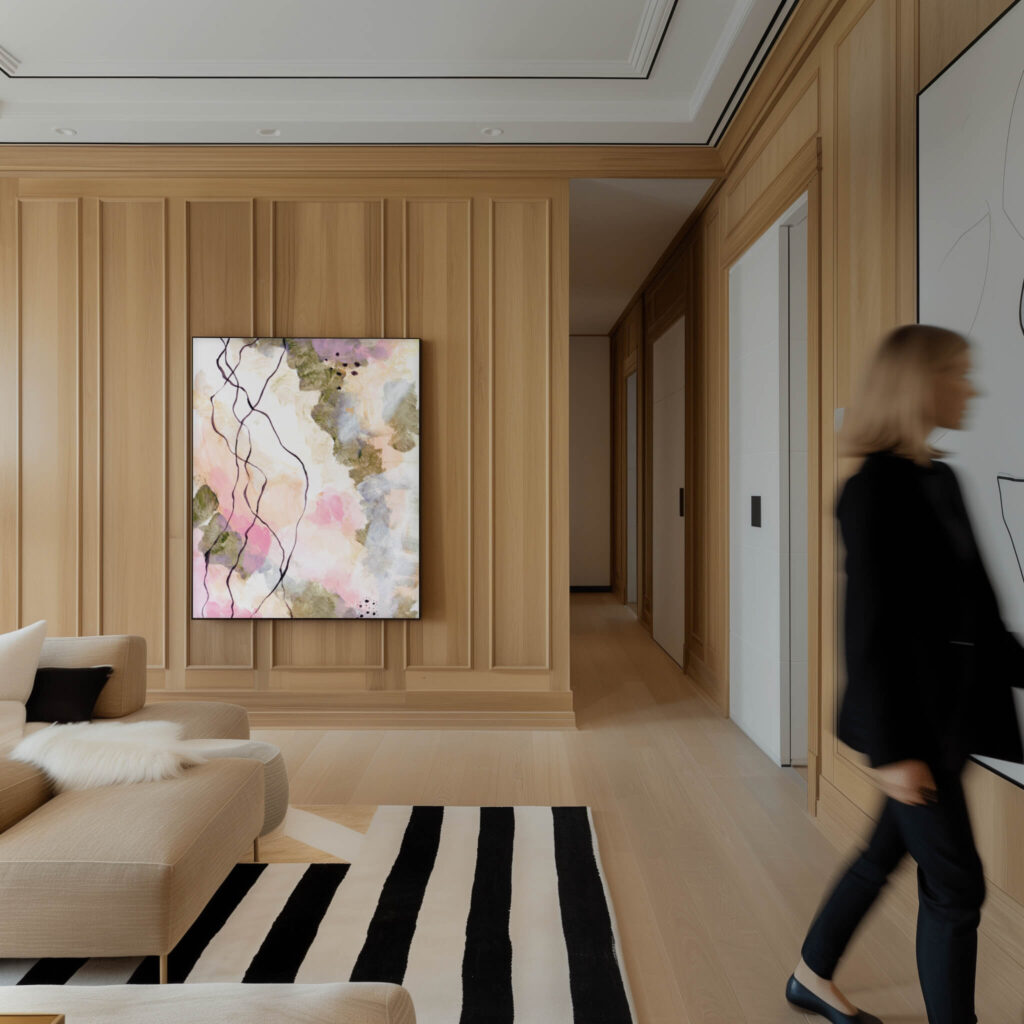
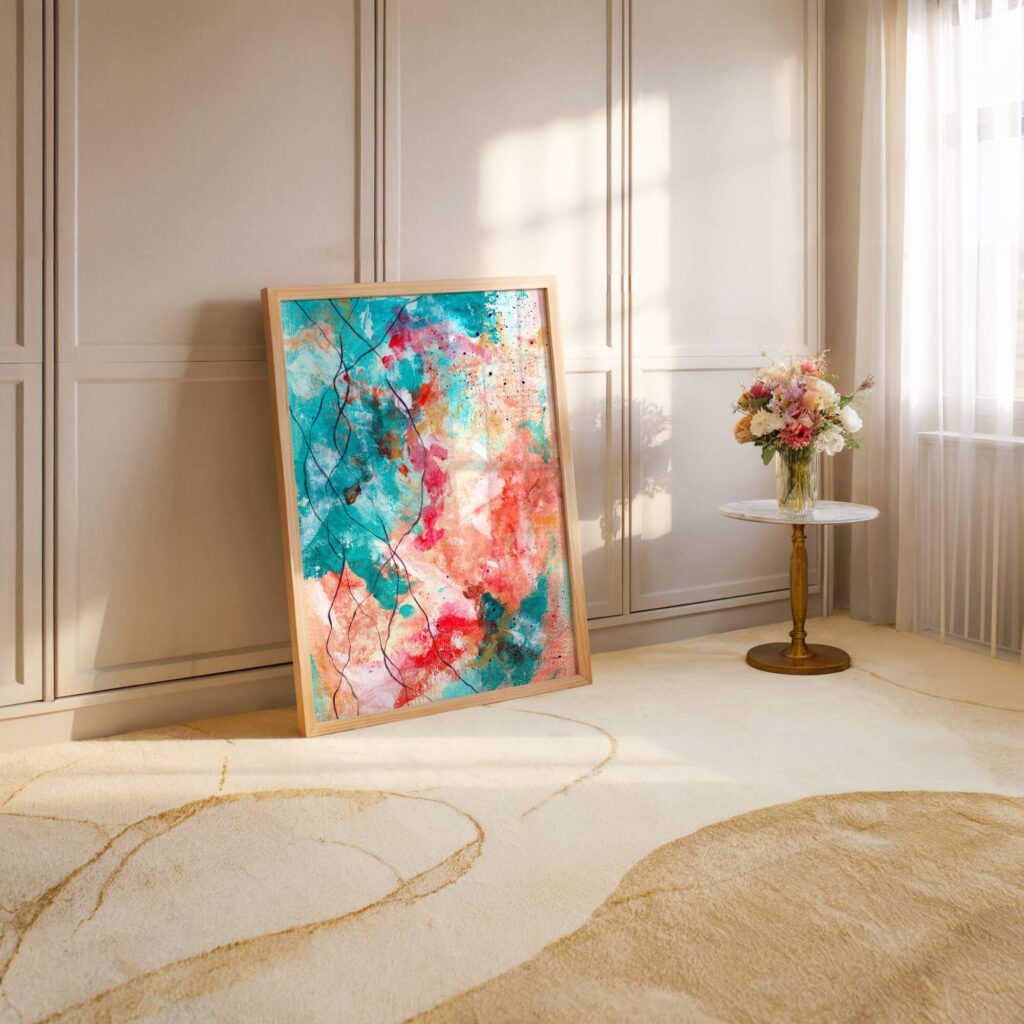
What Abstract Art Really Is (And What It Isn’t)
It’s not decorative. And it’s not random.
Let’s just get this out of the way: good abstract art isn’t “just a bunch of shapes.” It isn’t wall filler, it isn’t a pattern, and it isn’t whatever’s trending in hotel lobbies this year. At its core, abstract art is about making emotion visible. Not by describing it, but by embodying it.
It’s the shape of tension you’ve never had words for. The colour of a memory that’s been buried under everything else. The quiet pulse underneath a moment of stillness.
Abstract art doesn’t try to show you something recognisable. It gives you something undeniable. That’s why it doesn’t explain itself. It doesn’t have to. Its impact isn’t logical. It’s physiological. Emotional. Sometimes even spiritual, though that part’s never forced.
If you’ve ever looked at a painting and felt something shift in your body without knowing why, you already understand abstraction. You just haven’t been told that your response is valid. That you don’t need to be trained to belong here. That what you feel is enough.
Abstract work invites interpretation, it doesn’t demand it.
One of the most freeing things about abstract art is that it gives you space. It doesn’t lock you into a fixed meaning. You can sit with a piece for years and see something new in it each time. Not because it’s changing, but because you are.
Where traditional art says: “this is what you should see,” abstraction says: “what do you notice now?”
It’s not passive. It’s participatory.
It’s the difference between being talked at and being invited into a conversation.
That’s also why it can be so healing. Because abstract work doesn’t rush you. It doesn’t need you to be in the right mood, or to understand anything in particular. It simply holds space. You can show up overwhelmed, burnt out, grieving, or hopeful, and it will still meet you where you are.
A Quick History (Without the Lecture)
Abstract art didn’t arrive out of nowhere. It has roots, but not in the way textbooks often frame it.
The desire to create non-representational marks is as old as art itself. You can find abstract symbols scratched into stone tens of thousands of years ago. Indigenous traditions, spiritual diagrams, Islamic geometry, Aboriginal dot paintings, all explored abstraction long before it had a name in the Western canon.
But the version of abstract art that dominates galleries today — the kind that lets go of form, lets texture and colour lead, and prioritises inner experience over outer accuracy, took hold in the early 20th century.
Some of the key shifts:
-
-
Hilma af Klint, a Swedish mystic and painter, created fully non-objective works as early as 1906, long before Kandinsky, but instructed her family to hide them until 20 years after her death. She believed the world wasn’t ready.
-
Kandinsky painted what he called “compositions,” where music and colour fused. He believed painting could create emotional frequencies the same way music does.
-
Mondrian reduced everything to its essence, line, shape, primary colour, aiming to express a universal order, a stillness beyond the surface.
-
Rothko filled entire canvases with colour so saturated, so quiet, that you feel like you’re being pulled inside them.
-
Pollock turned the act of painting into a performance, dripping paint from above like a ritual. The result: not chaos, but raw, rhythmic emotion.
-
None of these artists were copying each other. They were simply trying to go beyond realism, to give us something we couldn’t find in physical objects. That’s still what abstract art does now. Especially at the high end, where the most powerful pieces are no longer just about form or fame. They’re about feeling. And if you want to understand abstract art, truly understand it, not just define it, that’s where you start. With what it moves in you.
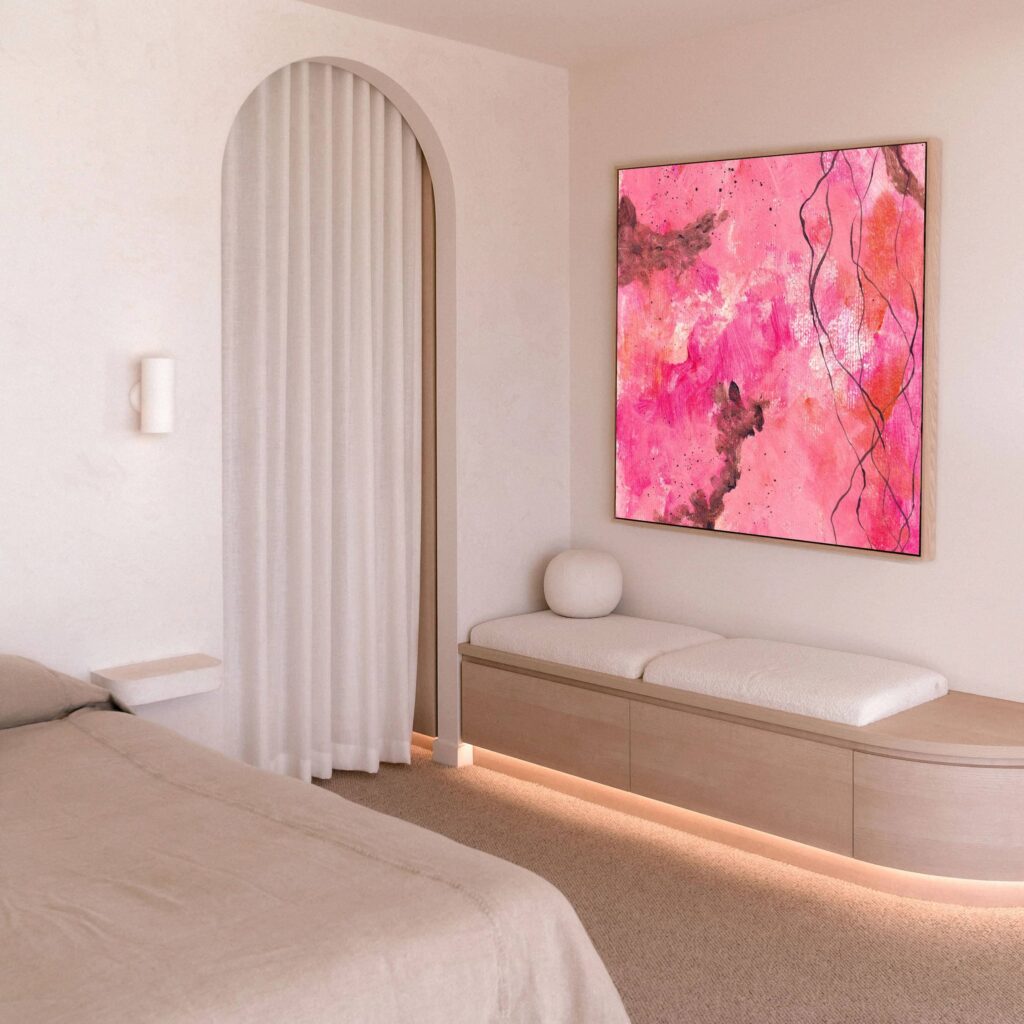
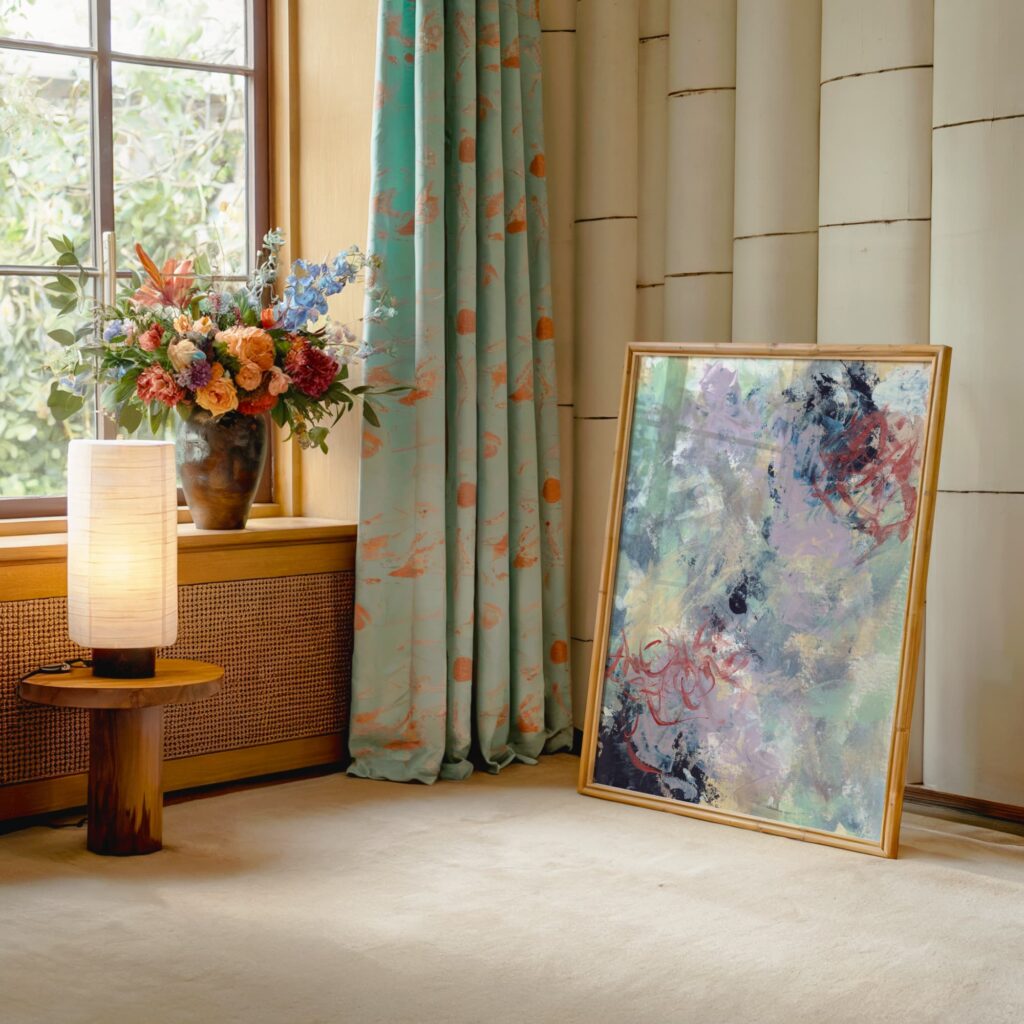
What Abstract Art Actually Does
Let’s talk about impact. Because abstract art isn’t passive. It’s active. It shapes the emotional field of the room. It alters the way people feel in a space. And if chosen well, it becomes a kind of anchor, not for your furniture, but for your nervous system.
It holds emotion without dramatising it.
A good abstract painting can carry grief without collapsing under it. It can hold joy without forcing it. It doesn’t shout. It doesn’t explain. It just lets the emotion exist, in shape, in colour, in silence.
That’s why it works so beautifully in healing spaces, meditative homes, and trauma-aware environments. It doesn’t stimulate in the way figurative work can. It regulates.
It allows people to form their own relationship with the work.
Unlike representational art, which often centres on the artist’s story, abstract work becomes something shared. It doesn’t just live on the wall. It lives in the viewer’s interpretation. A collector might see resilience in a piece. A guest might see longing. You might just feel calm. All are valid. All are real.
That multiplicity is a strength, not a weakness. It makes the work more human. More layered. And ultimately, more valuable over time.
It shifts a space without needing to dominate it.
In high-end interiors, art isn’t just an accessory. It’s a conversation. Abstract work allows a space to breathe while still holding presence. It adds depth without noise. And when placed well, it becomes the thing people remember, not because it matched the colour scheme, but because it made them feel something they didn’t expect to feel.
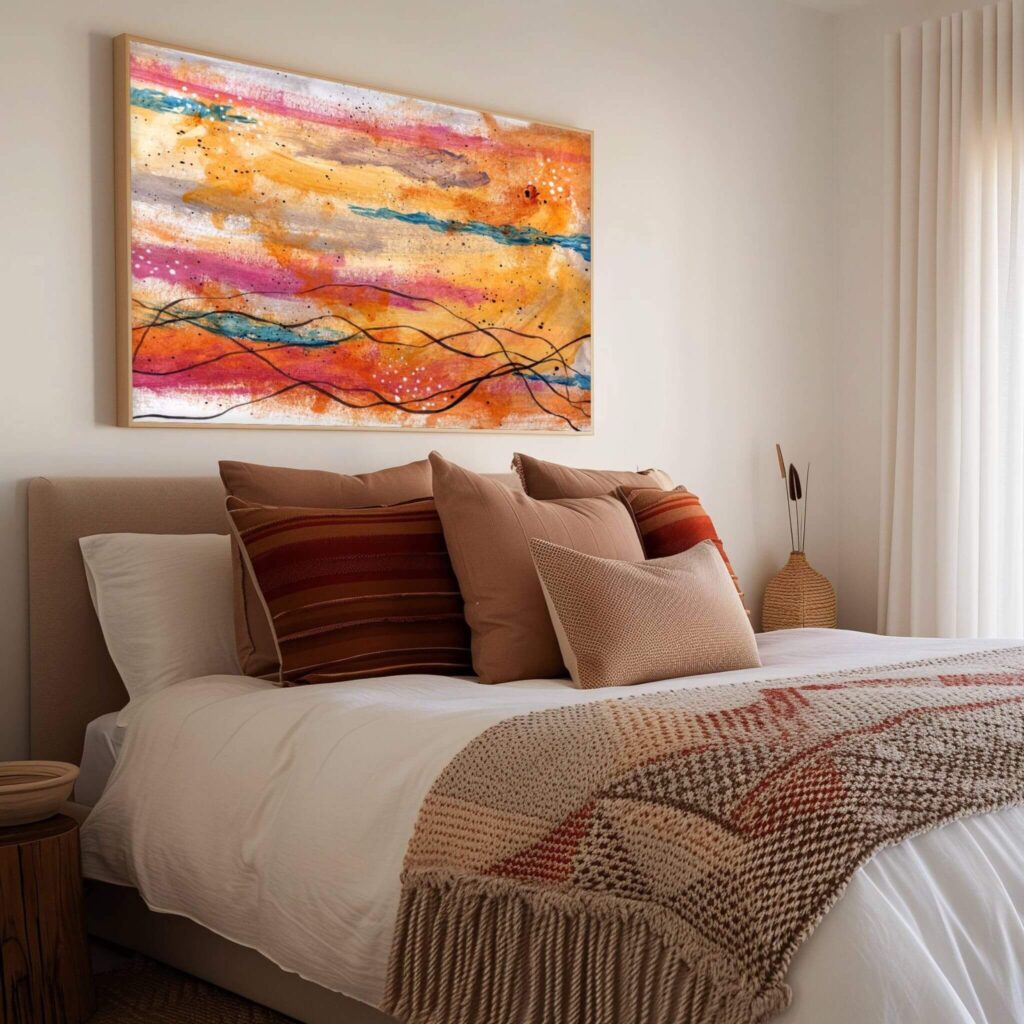
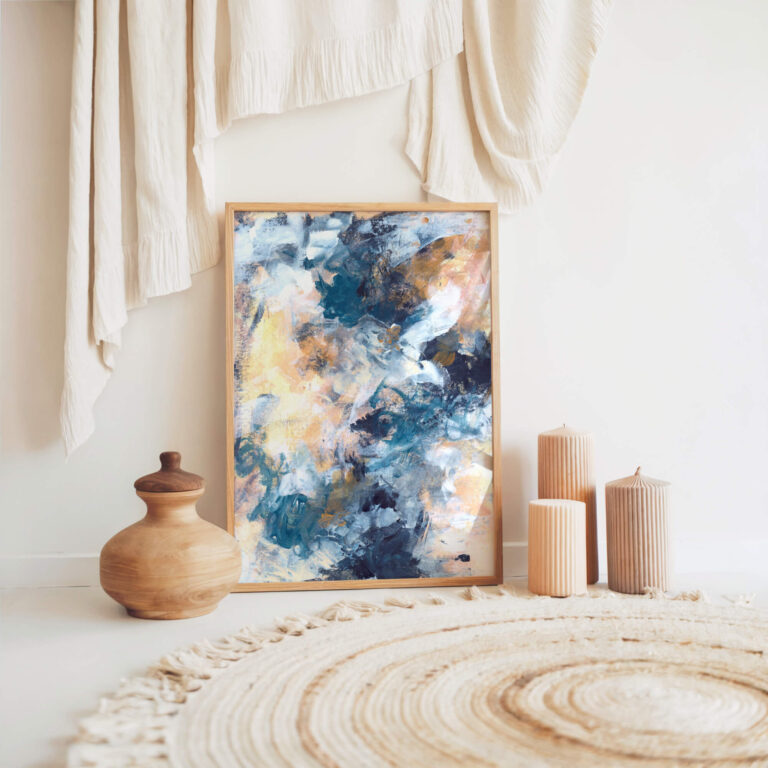
The Major Styles of Abstract Art (And What They Invite Into a Room)
One of the most common questions I hear is, “What kind of abstract art should I get?” The answer: start with how you want to feel.
If you’re trying to understand abstract art and how to choose what’s right for you, this is where to begin.
Every style of abstraction brings something different into a space. Some pull you inwards. Some energise. Some create stillness. Some stir memory, rhythm, tension, clarity. When you choose from that place, from what you want the space to hold emotionally, it stops being about trends and starts becoming personal.
Here’s a breakdown of the main styles that show up in contemporary abstract art. You don’t need to memorise these. You just need to notice what your body does when you’re around them.
1. Lyrical Abstraction
Soft movement, emotion-led gestures, gentle intensity
This style often feels like the painting is breathing. You’ll see layered strokes, expressive lines, delicate transparencies, and a rhythm that moves like music. It’s not loud. It’s not static. It feels felt, not designed.
Emotional tone: introspective, fluid, reflective, slightly raw
Works well in: bedrooms, reading spaces, therapy rooms, quiet corners
When to choose it: when you want art that feels like a memory you can’t quite name
If the work feels like it was made in motion, but with feeling, not force, you’re probably looking at something lyrical. It doesn’t always ask to be noticed. But once it’s in a room, it’s hard to forget.
2. Colour Field Painting
Large blocks of tone, soft edges, immersive presence
This isn’t about shapes or composition. It’s about scale and saturation. The most famous examples are Rothko’s, vast, quiet, almost sacred fields of colour that pull you in and slow you down.
Emotional tone: contemplative, immersive, expansive
Works well in: lounges, entrance halls, open-plan spaces, executive suites
When to choose it: when you want the space to feel calm but grounded, like a held breath, not a blank wall
A colour-field piece doesn’t shout for attention. It anchors the room in something slower, softer. A single block of deep blue or burnt sienna can change the entire way people move through a space.
3. Geometric Abstraction
Precision, balance, line, harmony
This is the more structured side of abstraction. Think Mondrian, but modern. Clean shapes, mathematical spacing, architectural rhythm. You’ll often find grid-based layouts, repeated motifs, or patterns that create a quiet sense of logic.
Emotional tone: ordered, modern, spacious, mentally clear
Works well in: contemporary offices, workspaces, minimalist interiors
When to choose it: when you want to evoke clarity, intelligence, and understated confidence
But don’t mistake this for coldness. When done well, geometric abstraction doesn’t sterilise a room, it clarifies it. It can bring precision without pressure. Like a breath of fresh air on a cluttered mind.
4. Action Painting / Abstract Expressionism
Movement, emotion, visceral energy
This is the boldest one, the Pollock lineage. Drips, splashes, slashes, bold strokes, raw energy left visible. These works are physical. Emotional. Sometimes uncomfortable. Always unforgettable.
Emotional tone: energetic, cathartic, chaotic but alive
Works well in: large social spaces, galleries, rooms that need drama or intensity
When to choose it: when you want a space to feel charged, expressive, or emotionally raw in the best way
Not for the faint-hearted. But if you’re looking to create a visceral, emotional focal point, something that reminds people art is alive, this is it. Be warned though: this work dominates a room. You don’t buy it to blend in. You buy it because you’re ready to feel something every time you walk past it.
5. Minimalist Abstraction
Quiet, reduced, essential
At first glance it might feel like “nothing’s happening.” But look again. Minimalist abstraction is about the energy of restraint. One mark. One gesture. Subtle changes in tone or texture that reveal themselves over time.
Emotional tone: clean, spacious, sacred, pure
Works well in: serene homes, architectural spaces, meditative rooms
When to choose it: when you want your art to clear space, not fill it
These works don’t perform. They hum. They whisper. They hold a kind of spiritual resonance that deep-feeling collectors often find hard to articulate, but instantly feel at home around.
A Note on “Mixed Styles”
Many artists, myself included, don’t work strictly in one category. We blend. A piece might carry the energy of a lyrical painting, but use minimalist composition. Or it might have geometric foundations beneath expressive brushwork.
That’s not a weakness. It’s depth.
The most emotionally powerful abstract works often sit between labels. That’s where the tension lives. That’s where the viewer gets to decide how close they want to stand.
So instead of asking “what style is this?”, try asking “what is this inviting me to feel?” That’s the real metric.
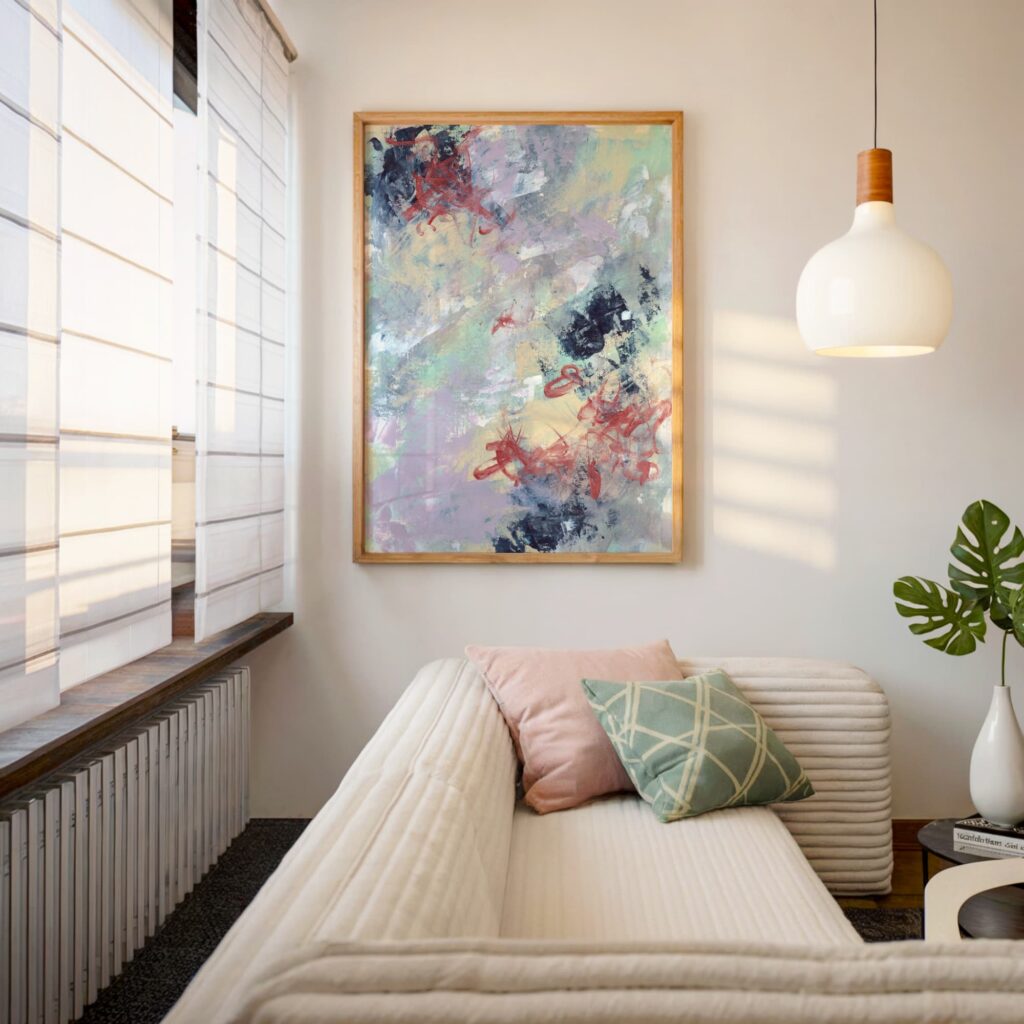
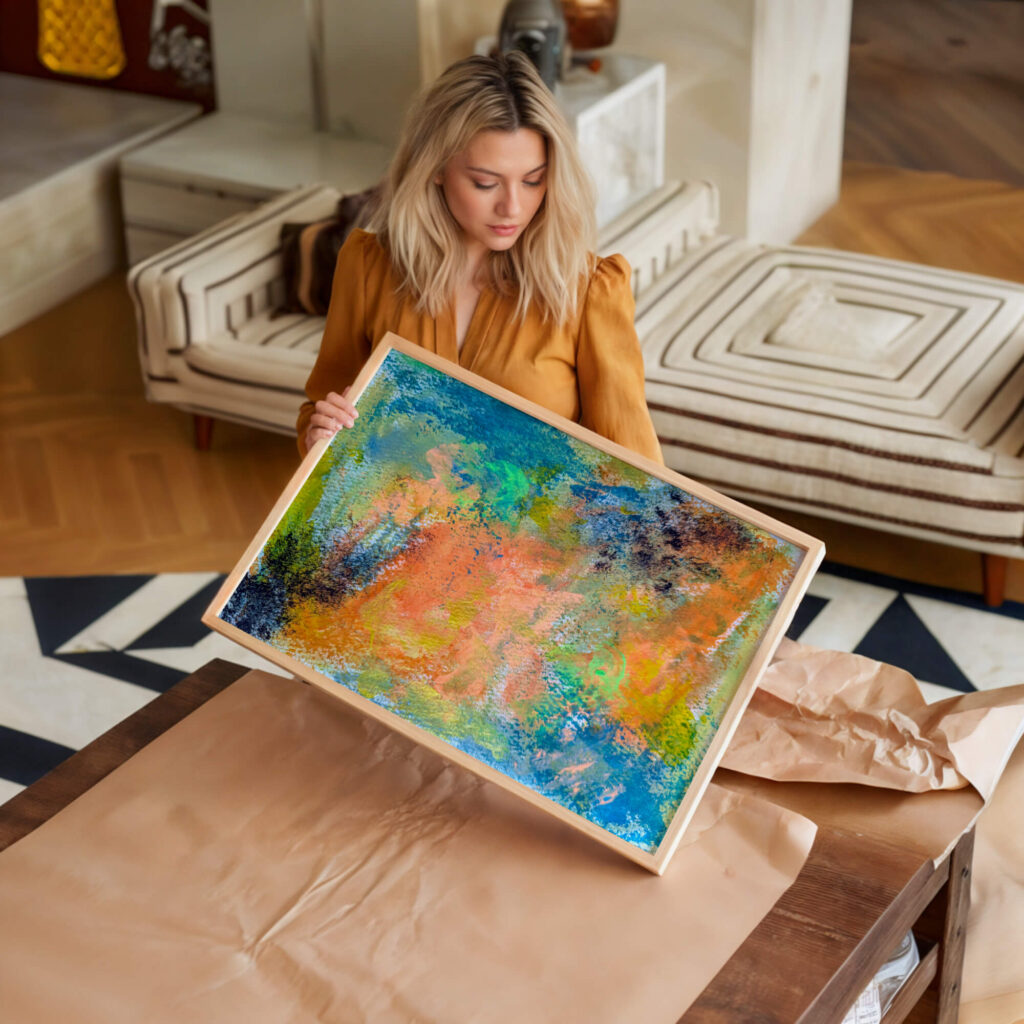
How to Choose Abstract Art That Actually Belongs in Your Space
There’s a difference between placing a painting and letting a painting become part of the room. One feels staged. The other feels like it’s always been there, like it’s holding something you didn’t realise needed to be held.
That’s the goal. Not just finding something that looks good next to a chair, but something that belongs with the energy of the space. Something that adds presence, depth, breath. If you’re learning to understand abstract art, this is one of the most overlooked parts, noticing what the piece is doing in the room, not just on the wall.
Here’s how to begin choosing with that kind of intention.
Start With What You Want to Feel
Skip the style guides. Forget what’s trending. Ask this instead:
What do I want the space to hold emotionally?
Do you want people to feel soothed when they walk in? Uplifted? Grounded? Introspective? Energised?
Abstract art gives you the ability to build that energy, through colour, texture, scale, rhythm. But you have to decide what tone you’re trying to create first.
A few examples:
-
-
If your space is a retreat, a refuge, or a slow living room, look for works with soft edges, layered textures, and a quieter palette. Think natural tones, brushstrokes that breathe, compositions that don’t rush to resolve.
-
If it’s a space for conversation, ideas, or creative energy, go for a piece with tension. Contrast. Movement. Something that invites curiosity without feeling chaotic.
-
For workspaces, a well-placed geometric or minimalist abstract painting can create a sense of calm focus, especially when paired with natural materials and negative space.
-
This isn’t about decoration. It’s about resonance. You’re building a visual frequency that people will feel the second they walk in.
Let Scale Do the Talking
Big mistake people make? Choosing art that’s too small for the space.
Abstract art needs breathing room. It’s not meant to hide behind a lamp or disappear between furniture. It’s meant to hold its own, not because it’s loud, but because it’s alive.
Rough guideline (but always break rules for the right piece):
-
-
Small space with high ceilings: vertical compositions, 100–120 cm tall
-
Large open-plan rooms: oversized works (150–200 cm wide), or diptychs/triptychs that span 2+ metres
-
Entryways and hallways: long, narrow abstracts with horizontal energy to carry the eye
-
Bedrooms and meditation spaces: square or softly framed abstracts that don’t overstimulate, think presence, not performance
-
And if you’re commissioning a piece, don’t underestimate scale. A 90×90 cm canvas might look big in your hands, but once it’s on a white wall in a high-ceilinged room, it can vanish.
Bigger isn’t always louder, but it is bolder. And bold doesn’t mean aggressive. It means clear. Sure of itself. The kind of art that doesn’t beg for attention, it just holds it.
Choose Colour Like You Choose Fragrance
Ignore colour theory. Pay attention to your body.
When you stand in front of a piece and your chest softens, or your breath deepens, that’s colour doing its work. Not by matching your curtains. But by matching your nervous system.
Colour is a sensory language. It doesn’t need to be logical. It just needs to be honest.
Some things to notice:
-
-
Do certain colours energise you or calm you down?
-
Do you want the piece to echo your interior palette or break it open?
-
Do you crave complexity or simplicity?
-
Neutrals aren’t always safe. Sometimes they’re just… dull. And sometimes a single shot of saturated ultramarine or deep sienna brings a room to life.
Let the colour surprise you. Let it lead. Let it bring something new into the space, not just reflect what’s already there.
Texture Matters More Than You Think
You can feel texture even when you don’t touch it.
A raw, heavy brushstroke. A scratched backlayer. A transparent glaze over a solid block. These elements all register in the body, they add dimensionality, weight, and honesty to a painting.
Flatness isn’t the same as simplicity. Some of the most minimalist works are quietly textural, and that’s what gives them emotional resonance.
If you’re choosing between a digitally printed piece and a hand-built one, always choose the one with presence. You can feel it. Even before you understand it.
How to Brief an Artist (And Actually Get What You Want)
If you’re commissioning a piece, clarity matters, but control kills it.
Here’s how to brief an abstract artist in a way that gets results without smothering the process:
-
-
Describe the energy you want the piece to hold.
Use words like grounded, expansive, calming, resilient, layered, rather than “blue with a bit of yellow.” Give the artist room to interpret. -
Share a photo of the space, but not to match colours.
Let the artist feel the space. The light, the tension, the softness, the architecture. It’s not about matching. It’s about building something that belongs. -
Be open to surprise.
Commissioned work is a dialogue. You’re not buying a product. You’re inviting a piece of someone’s soul into your home. That can’t be factory-controlled.
-
If you find an artist whose emotional language speaks to yours, let that trust guide the process. The best collectors don’t micromanage. They collaborate.
Mistakes to Avoid (So You Don’t Regret It Later)
-
-
Choosing based on colour swatches
Paintings aren’t throw pillows. If it blends too well, it disappears. Instead, choose for emotion. Tone. Presence. -
Buying to impress someone else
You’re the one who has to live with it. If it doesn’t move you, don’t buy it, no matter who else loves it. -
Underestimating scale
If it looks just right online, it’s probably too small in real life. Measure. Then go up a size. -
Thinking abstract = easy
It’s not. It’s layered, intentional, and complex, when done properly. The worst abstract art looks like a rushed afterthought. The best looks like it’s always been here.
-
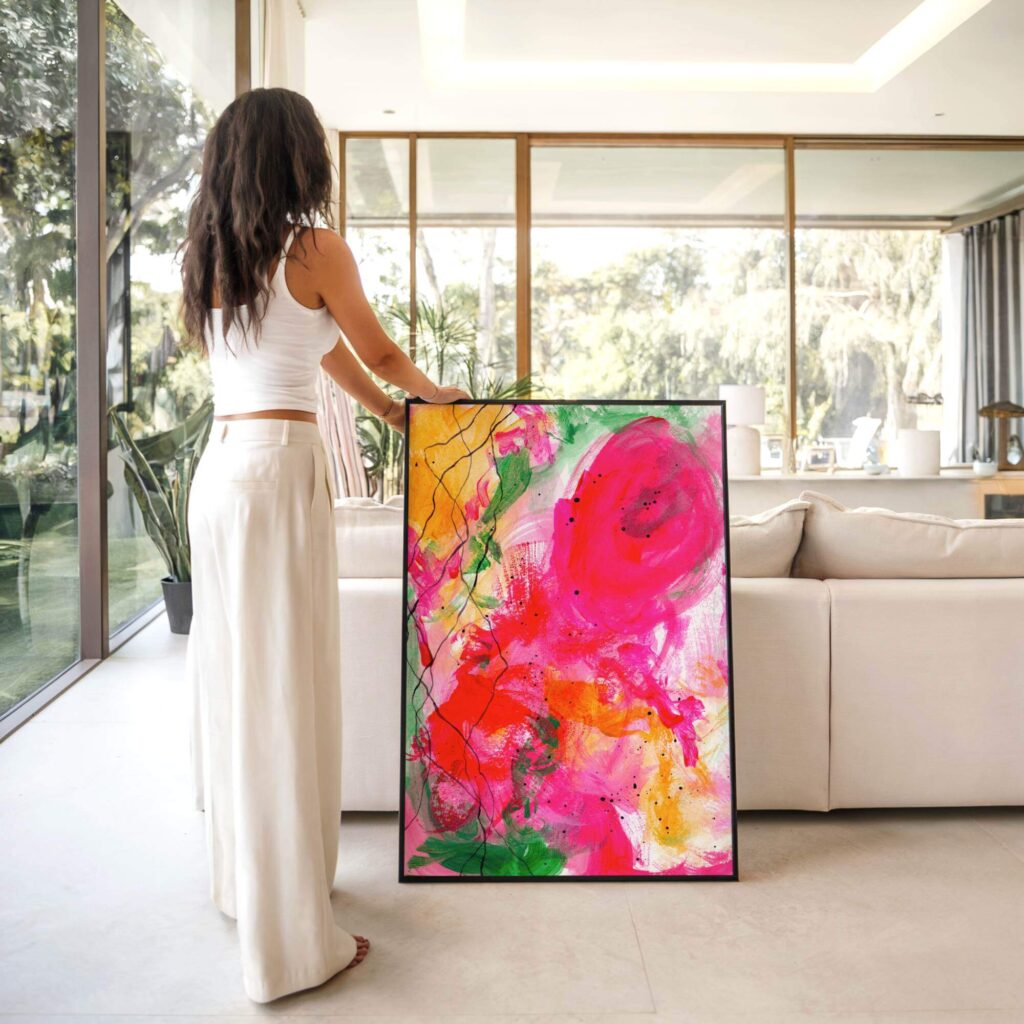
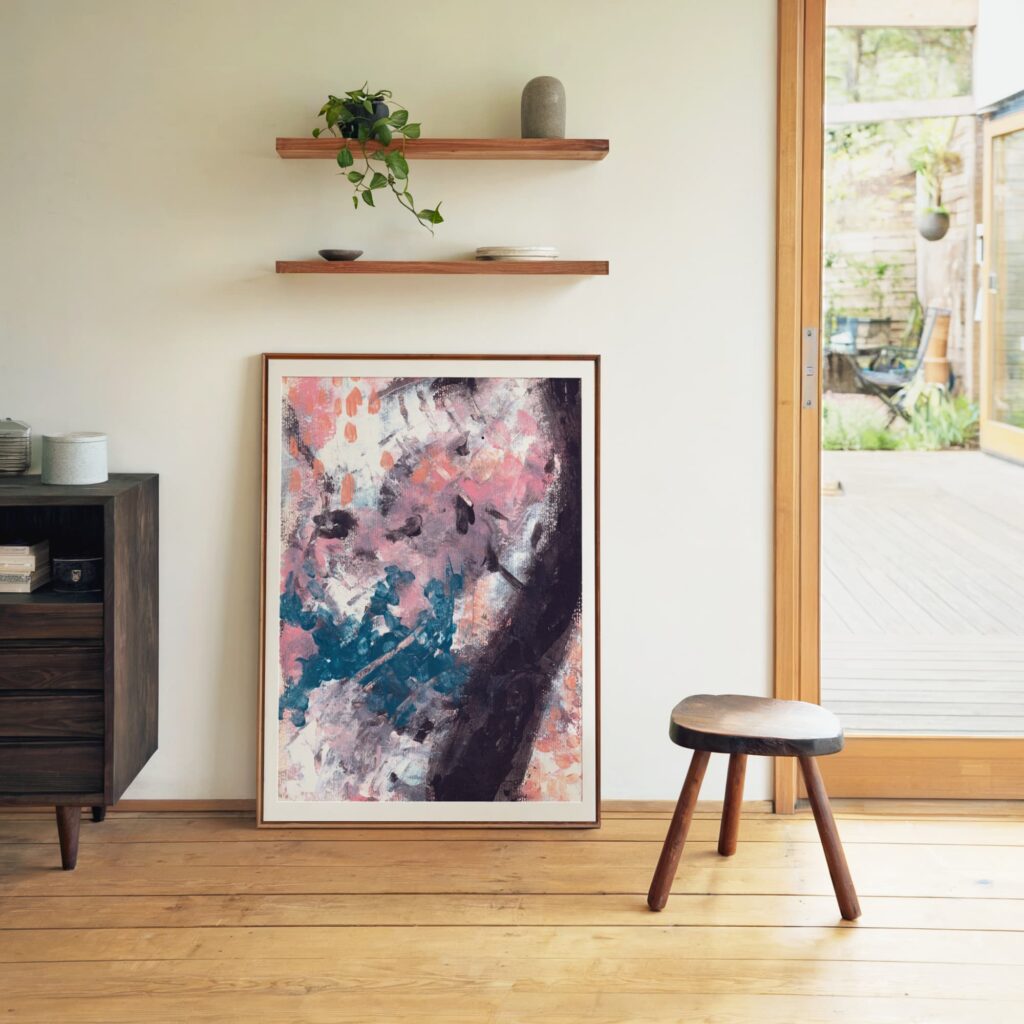
Why Abstract Art Belongs in Every Emotionally Intelligent Luxury Interior
It’s not a coincidence that luxury architects, wellness designers, and art collectors keep circling back to abstract work. It’s not just about visual appeal. It’s about what abstraction holds. What it invites. What it makes possible inside a space that was otherwise just beautiful.
To truly understand abstract art, you have to feel what it’s doing in your body, not just your eyes. The best interiors aren’t built for photos. They’re built for how you feel when you sit down. When you take your shoes off. When your body finally exhales.
That’s why serious collectors, CEOs, and wellness-led designers choose abstract art, not because it’s neutral, but because it allows people to feel safe inside complexity. It doesn’t direct the viewer. It holds them. And that’s exactly what luxury design should do too.
Stillness is the New Status Symbol
Loud wealth is out. Quiet power is in. And nothing speaks to quiet power like a room where everything has been chosen for how it feels, not how it performs.
In 2025, status isn’t measured in logos. It’s measured in presence. In taste. In curation. In how the room regulates you when no one else is there.
And that’s where abstraction excels.
Because you don’t have to “get” a painting to be changed by it. You just need to feel its honesty. Its weight. Its refusal to entertain or explain.
That’s what high-end clients are buying now, not a product, but a pause. A shift. Something that slows the nervous system without dimming the senses.
Abstract Art in Executive Spaces
Let’s be honest, most offices aren’t built for presence. They’re built for productivity. And it shows.
But when abstract work is placed intentionally, in executive suites, therapy rooms, creative studios, or wellness-led boardrooms, it shifts the entire dynamic.
Not by making noise, but by creating space. Space to breathe. To think clearly. To step out of urgency and back into yourself.
In a high-pressure environment, abstraction functions like a visual reset. It doesn’t lecture. It doesn’t demand attention. It just sits there, calm, grounded, dignified. A reminder that complexity doesn’t have to mean chaos.
This is why I often recommend lyrical or colour-field works for offices, not just for their aesthetic, but for what they do to the energy of the room. They help the space hold emotion without leaking it. They hold intellect without overstimulating the mind. They balance clarity and depth, which is exactly what the people in those rooms are trying to do too.
The Right Abstract Work Doesn’t Just Match the Room, It Completes It
Let’s talk design for a second. Because there’s a common trap I see all the time, especially in high-end spaces.
People spend tens of thousands on bespoke cabinetry, natural materials, low-profile lighting, and curated furniture, and then slap a generic canvas print on the wall because it “pulls the palette together.”
No. Just no.
Art isn’t there to match. It’s there to expand. To hold the tension between what’s known and what’s felt. When chosen properly, abstract work is what makes a room unforgettable. Not for its styling, but for its atmosphere.
A few placement principles I swear by:
-
-
Give the painting space.
Don’t cram it between light switches. Let it breathe. -
Use lighting to support its energy, not flatten it.
Side lighting brings out texture. Soft directional light builds intimacy. Avoid harsh LEDs. -
Let the painting carry emotion, not just colour.
If the room is minimalist, the painting doesn’t need to be beige. It needs to be grounded. -
Hang at eye level, your eye level, not a gallery’s.
You’re not curating for the art world. You’re building a sanctuary.
-
What Collectors Actually Look For (And What They Avoid)
High-end collectors aren’t looking for trends. They’re looking for truth.
That doesn’t mean the painting needs to be autobiographical or overtly deep. It means the work needs to feel alive. Not mechanical. Not decorative. Not generic.
Here’s what gets their attention:
-
-
Emotional resonance; the piece needs to do something, not just decorate.
-
Visible texture or gesture; something that shows the artist’s hand, not just their idea.
-
A sense of originality without chaos; collectors want depth, but they want control too. No one wants to hang visual overwhelm in their home.
-
Clarity of voice; even in abstraction, the artist’s tone should come through. If you can’t feel who made it, it often feels empty.
-
What they avoid:
-
-
Overly trendy palettes
(especially the “Millennial Beige” phase everyone’s recovering from) -
Digital prints that mimic brushwork
They can spot it a mile away, and they’re not buying simulation. -
Art that feels made to sell
If it feels too polished, too obvious, or too calculated, the answer’s no. Even if it’s technically perfect.
-
Collectors don’t want perfection. They want presence.
Why Emotionally Intelligent Interiors Always Include Abstract Art
Because people don’t just want beauty. They want connection.
They want to walk into a room and feel different. Lighter. Slower. Seen. And abstract art can do that, quietly, consistently, without needing a single word.
It doesn’t explain your life back to you. It simply makes space for it.
That’s what makes it irreplaceable in emotionally intelligent interiors.
It bridges the inner and outer world.
It anchors luxury in feeling, not in flash.
And it reminds us, in rooms filled with polished stone, silent lighting, and all the right furniture, that what we’re really craving isn’t control. It’s permission to feel.

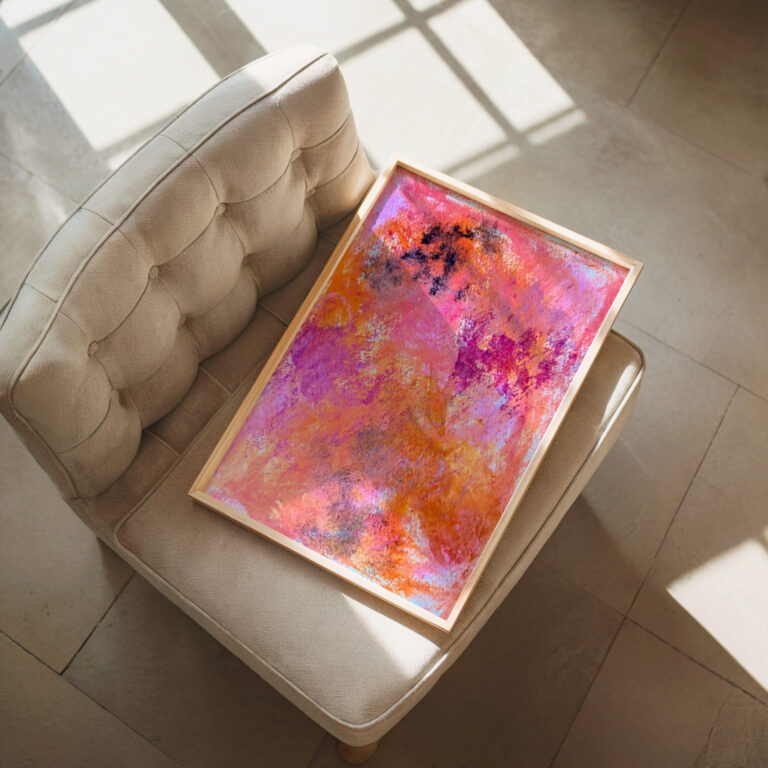
Why Abstract Art Speaks So Powerfully After a Life Has Been Broken Open
No one talks about it, but many collectors come to abstract art after a rupture. A loss. A turning point. A quiet unraveling they didn’t ask for. Not because the art explains what happened. But because it holds the aftermath.
To understand abstract art in this context is to realise it’s not an intellectual exercise, it’s an emotional one. There’s something in abstraction that mirrors the shape of healing. It doesn’t resolve. It doesn’t tidy up the narrative. It doesn’t need to. It simply lets things be. Raw. Real. Unfixed. Present.
In that sense, abstract art becomes more than something you hang. It becomes something that witnesses.
This is why so many emotionally intelligent buyers, especially those who’ve been through something hard, or who carry a private weight, are drawn to abstract work. Not because it fixes anything. But because it doesn’t demand performance.
The Nervous System Responds to Abstraction
You don’t have to understand a painting for it to regulate your body.
Certain textures, compositions, and colour frequencies lower physiological arousal. They slow the breath. They help shift the nervous system out of hypervigilance and into a state that’s closer to calm.
-
-
Soft, layered colour-fields allow the eyes to rest, especially when the edges blur and dissolve.
-
Lyrical compositions mimic the rhythm of breath, movement, emotion.
-
Textured pieces create a sense of realness and depth that flat visuals can’t offer. They ground you.
-
This isn’t theory. You feel it when it’s there.
That’s why I often tell people to stop overthinking their choices. If a piece makes your jaw unclench or your chest drop an inch, that’s the one. Your nervous system knows what it needs before your head catches up.
In Healing Spaces, Art Should Not Be Passive
Therapists, coaches, and wellness practitioners are finally starting to treat interiors as part of the healing process, not just a backdrop. And abstract art has become central to that shift.
Because it doesn’t distract. It doesn’t narrate. It allows each person to bring their own meaning.
In a space built for reflection or regulation, the right abstract painting does something extraordinary:
It gives permission.
It says: you don’t have to make sense yet.
It says: you are allowed to feel without explaining.
It says: there is room for everything here.
And that’s why it belongs in every space where stillness matters. Every space where someone is trying to find their way back to themselves.
When Life Changes, Abstract Work Helps You Mark the Shift
Buying a painting isn’t always about aesthetics. Sometimes it’s about anchoring a new chapter.
I’ve had people reach out after divorce. After recovery. After closing a business. After leaving something behind and not knowing what’s next.
They don’t want a souvenir. They want something that can hold the in-between. Something that reminds them not of where they were, but of who they’ve become in the aftermath.
Abstract art is perfect for that. Because it doesn’t say: “look what happened.”
It says: “here is what still remains.”
It says: “you are still here.”
Collectors often choose a piece because it mirrors the way they feel, not in the story, but in the tone. A heaviness softened by light. A scar overlaid with warmth. A bit of quiet after everything has been so loud.
That’s what real art does. It becomes part of the architecture of your life.
How to Choose Work That Ages With You
The best pieces aren’t trendy. They aren’t matchy. They aren’t chosen with a colour chart.
They’re chosen with the body.
If a painting invites you to stay with yourself, rather than escape, that’s a sign it will last.
If it continues to open something in you after the fifth, tenth, hundredth time you look at it, that’s a sign it’s worth the space.
If it holds multiple truths at once, grief and softness, tension and stillness, joy and ache, it will never go stale.
Because it will age the way you do. In layers. In nuance. In feeling.
That’s why abstract art makes such powerful legacy pieces. Not because of resale value (although that matters too). But because of what it carries through the years. What it absorbs. What it gives back.
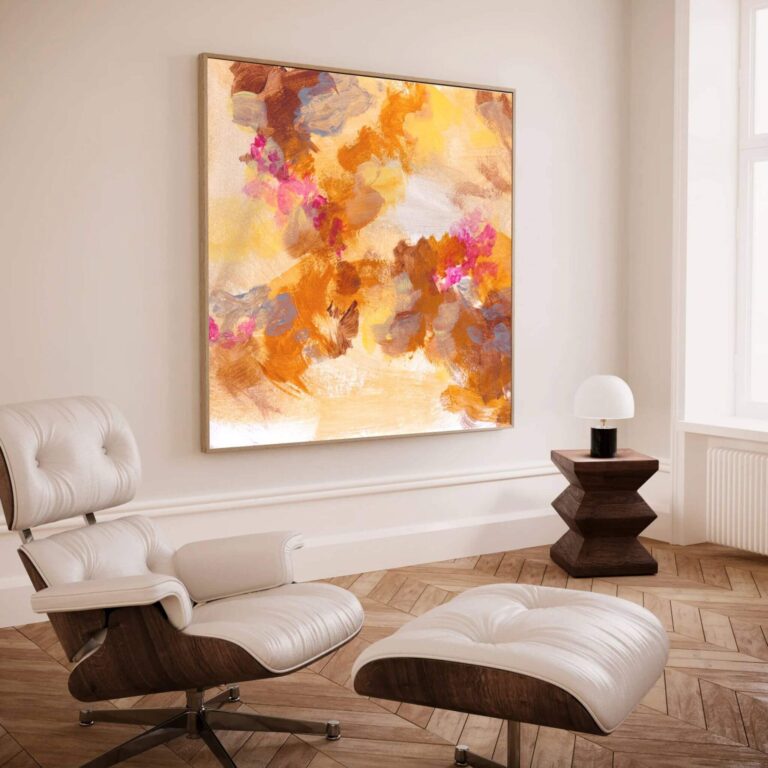
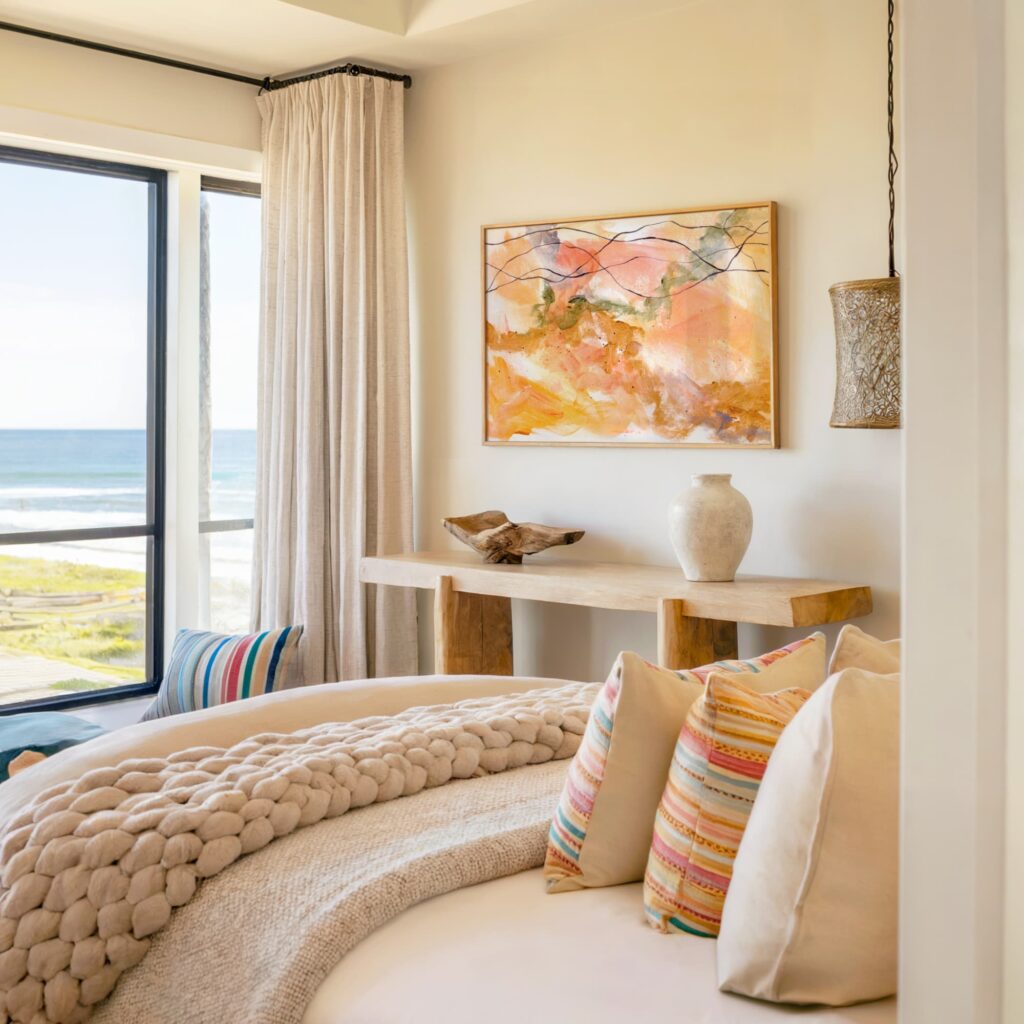
How to Build a Collection That Actually Reflects You
Collecting abstract art isn’t about having a wall full of impressive names. It’s about building a body of work that feels like yours, pieces that reflect where you’ve been, how you see the world, and who you’re still becoming.
It doesn’t matter if you’re just starting or already own ten originals. The most powerful collections aren’t built fast, they’re built with intention. With curiosity. With the courage to say: “This piece speaks to something I don’t have language for yet.”
That’s where the beauty lives. Not in perfection. Not in price. But in presence.
Buy Work That Changes You, Not Just the Room
If you’re choosing between a painting that makes the room look expensive and one that makes you feel more present, choose the second. Always.
Because the room can only hold what the art is carrying. And if the work feels empty or trendy or shallow, that’s what you’ve just woven into the space.
Look for pieces that create shift.
The ones that slow you down.
The ones that stop your thoughts for a second.
The ones you keep returning to, even though you can’t explain why.
If a painting asks something of you, even quietly, it’s worth listening.
What to Prioritise
Forget checklists. You only need a few things to build a powerful, layered, emotionally intelligent collection:
1. Emotion
Does it move you? Does it hold a frequency you recognise, even if you can’t name it? That’s your cue.
2. Texture
Flat work often feels… dead. Texture adds dimension. Weight. Honesty. It invites the eye to linger. It invites the hand, even if you never touch it.
3. Voice
Even if the work is minimal, you should feel the artist’s presence. Not performative. Not trying-too-hard. Just real. Confident in its own tone.
4. Energy
Some work holds space. Some shifts it. Some steadies you. Some charges you. Know what each piece is doing, and place it accordingly.
5. Trust in the artist’s process
If you feel connected to their practice, values, or emotional lens, their work will likely keep resonating. Especially over time.
What to Avoid
There are a few common traps, especially when people are new to collecting abstract art:
1. Buying work that’s “almost” right
If you feel slightly off about a piece, trust that. You’ll see that misalignment every day.
2. Matching the décor too literally
A painting is not a swatch. If you’re trying to pull together the colours of the sofa cushions, you’re already choosing from the wrong part of your brain.
3. Buying from marketplaces that mass-produce the same aesthetic
If it looks like it could be printed by the hundred, it probably is. And that energy will translate into the room, fast.
4. Choosing work that feels emotionally blank
Even if the colour is beautiful. Even if it matches the moodboard. If the piece has no depth, no tension, no honesty, it will flatten the space, not elevate it.
Think in Chapters, Not Just Pieces
Every collection tells a story. The question is, whose story are you telling?
The best collections don’t look cohesive. They look alive. They move through contrast and complexity, just like you do. One piece might be bold and expressive. Another might be restrained. One might reflect who you were five years ago. One might hold a truth you’ve only just admitted to yourself.
That’s how you know it’s yours.
You don’t need twenty pieces to build a meaningful collection. You just need one piece at a time, chosen with honesty.
And as you grow, your collection will grow with you.
That’s the kind of legacy that can’t be faked
If You’re Starting From Scratch
Start with what stops you.
You don’t need to know why. You don’t need to justify it. If a piece stays with you long after you’ve seen it, if you keep returning to it in your mind, that’s all the sign you need.
And if you’re overwhelmed by choice, commission. Find one artist whose work speaks to you. Ask for something personal, something rooted in the emotion you want the piece to hold. You don’t need to know what it will look like. You only need to know how you want to feel.
Let that be enough.
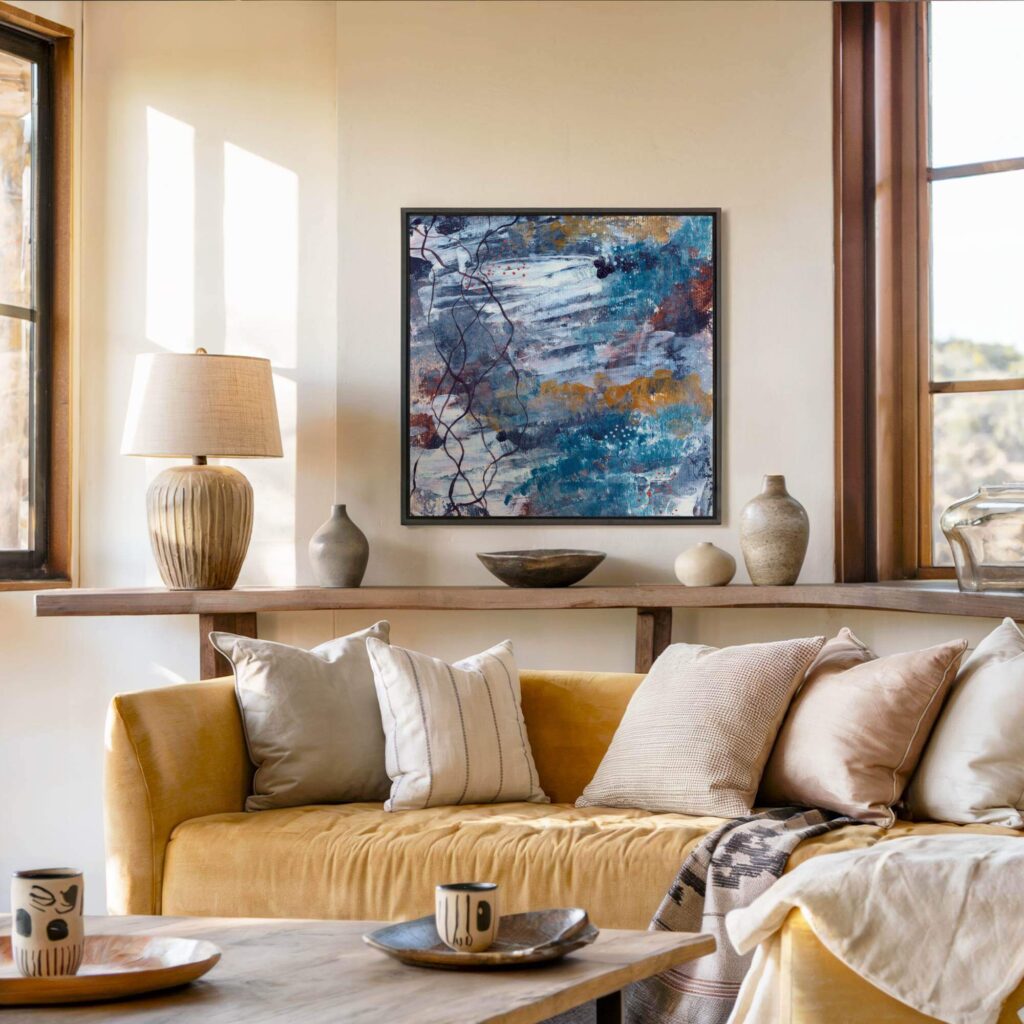

How to Protect Your Collection, Physically and Energetically
If a piece of art carries emotion, memory, or transformation for you, then it’s more than a decorative object. It deserves to be protected, not just from sunlight or scratches, but from carelessness. From being treated like a thing, when it’s not just a thing.
Here’s how to protect the work — and the relationship you have with it.
Physical Care Basics (Without the Fuss)
No need for over-complication. But a few essentials go a long way.
-
-
Lighting matters.
If you want colours to stay true, avoid direct sunlight. Use soft, low-temperature directional lighting, 3000K or below. Halogen spots might look gallery-worthy, but they’re often too harsh for textured work and natural pigment. -
Let it breathe.
Don’t wedge it in. Don’t surround it with noise. Leave at least 20–30cm of negative space around the frame. Art needs room to live. -
Control humidity.
Not obsessively — just enough. If your room fluctuates between damp and dry, it will affect natural fibres and stretcher bars. Keep rooms at stable temperature and airflow, especially if the piece is on raw canvas or archival cotton rag. -
If you move house, use professionals.
A courier might cost £300. A cracked canvas costs far more. Always wrap in glassine or acid-free paper, not cling film. Keep it flat. Mark the front. Don’t lean anything against it.
-
Energetic Care (Yes, That’s Real)
If you believe that art holds frequency, and let’s be honest, you do, then how it’s treated matters.
-
-
Don’t hang it where you rush past.
It changes nothing if you never notice it. -
Don’t let it become invisible.
Rotate works seasonally if you need to. Curate the walls like you curate your time, with presence. -
Clean it gently, intentionally.
No sprays. No polish. Just a dry microfiber cloth and a few seconds to reconnect. -
If a piece feels “off” after a change in your life, pay attention.
Art holds emotional residue. If it starts to feel heavy or irrelevant, it might be time to relocate it, or release it.
-
What Actually Matters in Preservation (And What Doesn’t)
Matters:
-
-
Original materials (canvas, paper, pigment quality)
-
How it’s hung (never in damp corners or direct light shafts)
-
How often it’s handled (less is more, treat with clean hands or gloves)
-
Doesn’t Matter:
-
-
Whether you framed it in museum glass (unless it’s fragile paper)
-
Whether you kept the receipt or certificate on display
-
Whether it’s been “professionally cleaned”, most abstract work should be left alone unless actually damaged
-
Collectors often obsess over the wrong things. What matters most is how you live with it. Not how you catalogue it.
When to Invest, When to Wait, and When to Let a Piece Go
You don’t need to buy now just because something’s available. You don’t need to say yes just because it’s from a respected name. And you definitely don’t need to justify waiting until a piece feels right.
Here’s how I see it:
-
-
Invest when your body says yes before your brain does.
That’s not recklessness. That’s resonance. -
Wait if it feels 80% right.
The wrong 20% will echo louder every day you live with it. -
Let a piece go when it no longer mirrors who you are.
It’s not failure. It’s evolution.
-
Art is alive. And part of respecting it, and yourself, is knowing when to close the chapter. Sometimes that means rehoming a piece with someone who needs it more now than you do. Sometimes that means moving it from centre stage to a quiet corner. Sometimes it means pausing and not buying anything at all.
Stillness is part of collecting too.
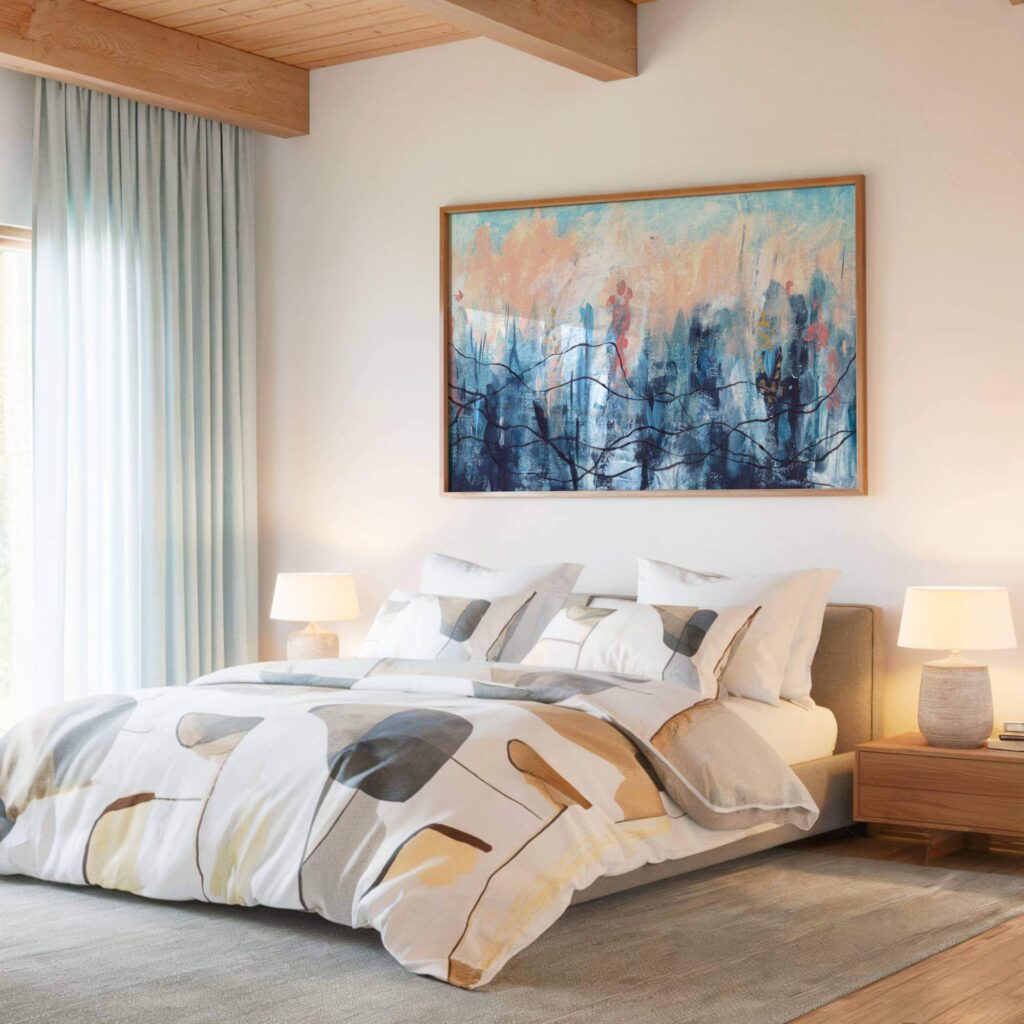
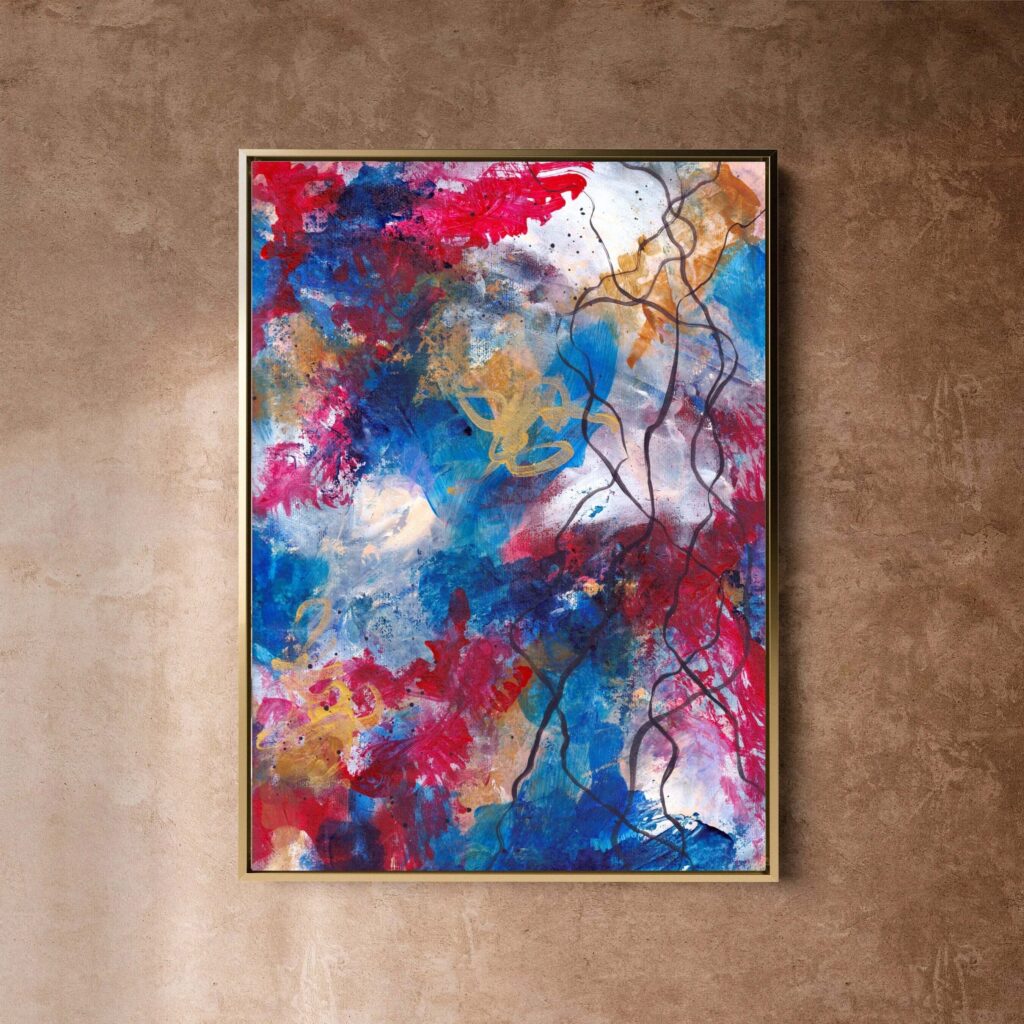
Conclusion: You Don’t Need to Be an Expert to Choose Art That Moves You
If you’ve made it this far, you already know, this isn’t about decoration.
Abstract art is presence. It’s space. It’s memory. It’s the shape of what can’t be spoken, hanging quietly in a room that now feels more like you.
Whether you collect one piece or a dozen, whether you buy from an emerging artist or commission privately from someone whose work feels like home, let it be honest. Let it be emotional. Let it be yours.
You don’t need to decode it.
You don’t need to defend it.
You just need to feel it.
That’s how you know it’s real.
If This Resonated, Here’s Where You Can Go Next
If something in this guide stayed with you, if you felt seen, softened, or called in- here are a few quiet ways to explore what working together could look like:
The Collector’s Vault
My online store of canvas works. Some are bold. Some are quiet. All were created to hold presence. If you’re drawn to colour, texture, and emotional resonance this is where you can browse without pressure. Enter the Vault →
Legacy Thread
A private collection of mid and large-format canvas prints, each tied to a chapter of my book Stillness Is a Weapon. These aren’t gallery editions. They’re emotional artefacts, the kind that transform a room by holding what words can’t. Request access here →
Soul on Canvas
If you want a commissioned piece made just for you, something that holds a feeling, a threshold, a transition, this is where I create those. Slowly, intentionally, with care. Explore the commission process →
Or if you’re not sure yet, just send a quiet not – hello [at] vikithorbjorn [dot] art
